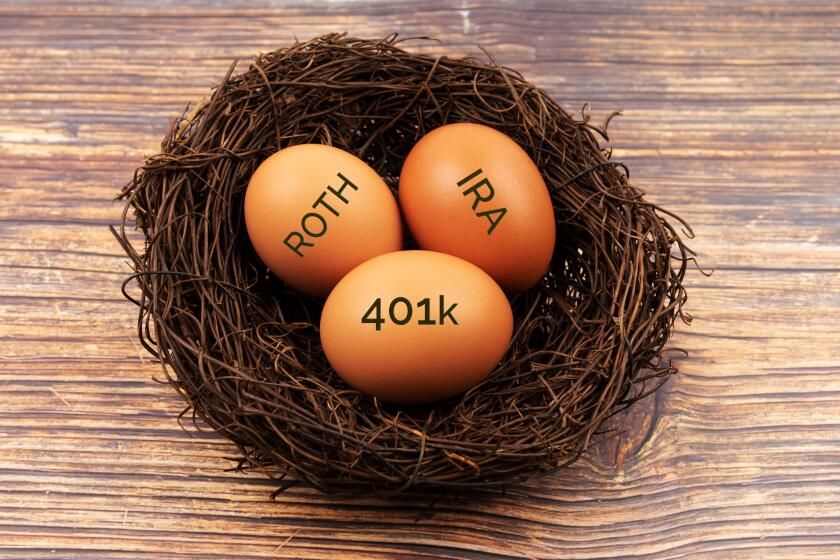An undeserved attack on the ‘undeserving poor’
- Share via
Amid the crowd-rousing shorthand employed by some American politicians, surely one of the hardiest chestnuts is the notion of the “undeserving poor.”
You know the spiel, which plays to old and discredited stereotypes. It defines welfare recipients as spongers, drunks, tomcats and loose women; anyone with a swarthy visage or Hispanic accent as likely an “illegal immigrant”; anyone on unemployment as a lazy good-for-nothing; anyone receiving government assistance (other than bankers and oil company executives, of course) as a chiseler.
The most modern variation on this theme aims to be somewhat more politically correct by branding these people as “non-taxpayers.”
There’s a tiny kernel of truth nestled within this phrase. According to the most recent calculations by the nonpartisan Tax Policy Center, about 46.5% of all tax filers pay no federal income tax. That’s a bit down from the peak of 50.8% reached in 2008 and 2009, but up from 39.9%, the figure for 2007. And it’s way ahead of the 21% to 26% range during the 1990s, as calculated by the nonpartisan Tax Foundation.
The number has inspired a new talking point for anti-tax conservatives. Their claim is that relieving half of all taxpayers of the burden of taxation reduces the constituency for tax reform — the half of all voters who don’t pay tax have no incentive to improve the system.
This is a transparently false rationale: The politicians making tax policy are now and have always been far more sensitive to the desires of the taxpaying sector, especially the wealthiest of them, than to the low-income earners, seniors, and students who constitute almost all of the non-taxpaying group.
It’s far more instructive to view this argument in the historical context of the “undeserving poor” meme. In olden times, before taxes became such an obsession of policy wonks, the label was most often applied to relief clients, especially when politicians or the newspapers found people collecting welfare while living high on their own wealth — the “lady in mink” phenomenon, as it was known after the New York papers turned up said lady wearing said garment to collect a check at her local welfare office in 1947.
The New Yorker’s legendary press critic A.J. Liebling subverted the whole yarn in a piece memorably entitled “Horsefeathers Swathed in Mink.” He determined that despite having collected a five-figure divorce settlement many years before, the woman now depended for survival, along with her 5-year-old daughter, on $5.40 a day from the city welfare department. The mink was a ratty and torn old thing worth a few hundred bucks.
Liebling identified the underlying theme of all undeserving-poor narratives: “that the poor are poor because of their sins and whatever they get is too good for them.” He might have added a corollary widely favored today especially by the GOP, that the rich are rich because of their inherent virtues and whatever they get is barely enough, because they’re our “job creators.”
Leaving aside the sad fact that the wealthy haven’t created so many jobs lately even though their top marginal income tax rates are at their lowest level since 1992, it’s not hard to draw a line between the 1940s view of the poor and contemporary discussions of tax policy. The Wall Street Journal editorial page did it succinctly in 2002, when the percentage of non-paying tax filers was about 30%. The editorialists labeled these people, almost all of whom were gathered at the lowest end of the income scale, as “lucky duckies” and attributed their good fortune, dismissively, to “a welter of tax credits for things like child care and education.”
What’s most important to keep in mind is that this critique of tax policy is necessarily selective. For one thing, the Journal’s pundits didn’t pay any attention to the luckiest duckies of all — wealthy non-taxpayers. The Tax Policy Center calculated that in 2009, about 123,000 tax returns reporting cash income over $200,000 also reported owing zero federal income tax — including 6,000 returns showing income over $1 million.
Moreover, by focusing on the federal income tax, which is progressive (it levies proportionately more on the wealthy than the not-so-wealthy), the critique overlooks the strongly regressive slant of the other taxes, including state and local taxes, paid by the middle class and working class. The most comprehensive analysis of state and local tax burdens comes from the Institute on Taxation and Economic Policy, another nonpartisan tax policy think tank. (How many of these things are there in Washington?)
The institute’s figures show that the poor are hardly objects of envy. In its most recent survey, the institute found that in 2007, the lowest 20% of income earners (earning less than $18,000 and averaging $10,700) paid an average 10.9% of their income in state and local taxes. The biggest bite was sales and excise taxes, which took 7.1%, followed by property taxes, which even renters pay through their rent, at 3.7%. Income taxes come in last, at 0.2%. If you apply the theory that tax exemptions make the poor uninterested in tax policy, these figures should dispel that. They pay plenty.
The state and local tax burden declines pretty steadily as one rises along the income ladder. The rich don’t pay nearly as high a proportion of their income as the poor. The top 1% of earners, who made $476,000 or more and averaged $1.8 million in income, paid an average of 5.2%, after deducting state and local taxes from their federal tax bills. The pre-deduction total comprised 4.2% in income tax, but only 0.9% in sales and excise taxes and 1.4% in property taxes.
Among major federal taxes, only income taxes are progressive. The effective personal income tax rate in 2007 for the lowest 20% was a negative 6.8%, thanks to all those tax credits that drive the Wall Street Journal’s editorialists up the wall. For the top 1%, it was 19%. Corporate income taxes are also progressive, though it’s harder to attribute them consistently to individual taxpayers.
But payroll taxes, especially for Social Security, helped narrow the difference: the effective Social Security and Medicare tax rate for the lowest 20% of wage earners was 8.8%, and for the top 1%, only 1.6%. That’s because Social Security tax is levied only on the first $106,800 of wage and salary income; the further your wages rise beyond that point and the more your income comes from dividends, interest, or capital gains, the lower your effective rate.
An unspoken subtext of the non-taxpayer argument is resentment over how the tax code has become the instrument for delivering government assistance to the needy. The underlying idea of proposals such as the flat tax is that taxes should be economically neutral — designed to raise revenue, period, not to promote any particular government policy.
But why? Taxation is the most effective way of communicating policy choices, and the most efficient. If the government decides it should assist the poor, why not use an established bureaucracy to get the checks out? (Social Security is a special case, since its bureaucracy manages a discrete revenue stream.) The Supreme Court has upheld the taxing authority of the federal government for almost any purpose, which is why we have tax provisions favoring homeownership, retirement security, and oil and gas exploration, among other things.
So let’s not forget what’s the real issue in the debate about non-taxpayers. It’s antagonism toward the government for helping out those in need. If anyone tells you anything else, that’s horsefeathers.
Michael Hiltzik’s column appears Sundays and Wednesdays. Reach him at [email protected], read past columns at latimes.com/hiltzik, check out facebook.com/hiltzik and follow @latimeshiltzik on Twitter.
More to Read
Inside the business of entertainment
The Wide Shot brings you news, analysis and insights on everything from streaming wars to production — and what it all means for the future.
You may occasionally receive promotional content from the Los Angeles Times.











